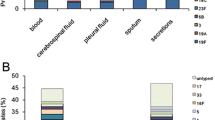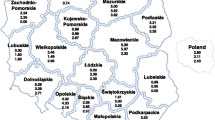Abstract
A prospective study was conducted to determine the serotypes and antibiotic resistance patterns of pneumococcal isolates from children with invasive pneumococcal disease (IPD) and acute otitis media (AOM). From October 2001 to May 2002, 65 children with IPD (28 bacteraemic pneumonia, 24 bacteraemia without focus, 7 meningitis, 6 other infections) and 78 with AOM were identified. The most common serotypes causing IPD were 14 (32.3%), 6B (20.0%), 1 (18.5%) and 19F (7.7%) whereas the predominant serotypes causing AOM were 19F (35.9%), 14 (16.7%) and 23F (9.1%). Sixty-nine percent of IPD and 70.5% of AOM were caused by vaccine serotypes. The vaccine serotypes were more commonly encountered in meningitis cases and in children younger than 2 years of age. Intermediate resistance to penicillin was observed in 6 of 65 (9.2%) IPD isolates, one of which was intermediately resistant to cefotaxime (1.6%), whereas none exhibited high-level resistance to penicillin or other beta-lactam antibiotics. A higher proportion of antimicrobial resistance was noted in AOM isolates; 29 of 78 (37.4%) exhibited intermediate resistance and 8 (10.2%) high level resistance to penicillin, four of which had intermediate resistance to cefotaxime. Significant resistance was also noted to erythromycin; 38.5% of IPD and 48.7% of AOM isolates were resistant. Multidrug resistance was observed in one IPD and in eight AOM isolates. Conclusion:these findings have implications in the potential use of 7-valent conjugate vaccine in our region.

Similar content being viewed by others
Abbreviations
- AOM :
-
acute otitis media
- IPD :
-
invasive pneumococcal disease
- MIC :
-
minimal inhibitory concentration
References
American Academy of Pediatrics (2000) Technical report: prevention of pneumococcal infections, including the use of pneumococcal conjugate and polysaccharide vaccines and antibiotic prophylaxis. Pediatrics 106: 367–376
Black S, Shinefield H, Fireman B, Lewis E, Ray P, Hansen JR, Elvin L, Ensor KM, Hackell J, Siber G, Malinoski F, Madore D, Chang I, Kohberger R, Watson W, Austrian R, Edwards K (2000) Efficacy, safety, and immunogenicity of heptavalent pneumococcal conjugate vaccine in children. Pediatr Infect Dis J 19: 187–195
Cartwright K (2002) Pneumococcal disease in western Europe: burden of disease, antibiotic resistance and management Eur J Pediatr 161: 188–195
Centers for Disease Control (2000) Pneumococcal disease. In: Epidemiology and prevention of vaccine-preventable diseases, 6th edn. Centers for Disease Control, Atlanta, pp 249–263
Dowell SF, Schwartz B (1997) Resistant pneumococci: protecting patients through judicious use of antibiotics. Am Fam Physician 55: 1647–1648
Hausdorff WP, Bryant J, Kloek C, Paradiso PR, Siber GR (2000) The contribution of specific pneumococcal serogroups to different disease manifestations: implications for conjugate vaccine formulation and use, part II. Clin Inf Dis 30: 122–140
Hausdorff WP, Bryant J, Paradiso PR, Siber G (2000) Which pneumococcal serogroups cause the most invasive disease: implications for conjugate vaccine formulation and use. Clin Inf Dis 30: 100–121
Hausdorff WP, Siber G, Paradiso PR (2001) Geographical differences in invasive pneumococcal disease rates and serotype frequency in young children. Lancet 357: 950–952
Hausdorff WP, Yothers G, Dagan R, Kilpi T, Pelton S, Cohen R, Jacobs M, Kaplan S, Levy C, Lopez EL, Mason EO, Syriopoulou V, Wynne B, Bryant J (2002) Multinational study of pneumococcal serotypes causing acute otitis media in children. Pediatr Infect Dis J 21: 1008–1016
Joloba ML, Windau A, Bajaksouzian S, Appelbaum PC, Hausdorff WP, Jacobs MR (2001) Pneumococcal conjugate vaccine serotypes of Streptococcus pneumoniae isolates and the antimicrobial susceptibility of such isolates in children with otitis media. Clin Inf Dis 33: 1489–1494
Kaplan SL, Mason EO, Barson WJ, Wald ER, Arditi M, Tan TQ, Schutz GE, Bradley JS, Giner LB, Kim KS, Yogev R (1998) Three-year multicenter surveillance of systemic pneumococcal infections in children. Pediatrics 102: 538–545
Kouppari G, Zaphiropoulou A, Stamos G, Deliyianni V, Apostolopoulos N, Legakis NJ (2000) Pneumococcal acute otitis media in children. Clin Microbiol Infect 6: 69–73
National Committee for Clinical Laboratory Standards. Performance standards for antimicrobial susceptibility testing; 12th informational supplement. NCCLS document M100-S12 (ISBN 1–56238–454–6)
Syriopoulou V, Daikos GL, Soulis K, Michos A, Alexandrou H, Pavlopoulou I, Pagali A, Hadjichristodoulou C, Theodoridou M (2000) Epidemiology of invasive childhood pneumococcal infections in Greece. Acta Paediatr Suppl 435: 30–34
World Health Organization (1999) Pneumococcal vaccines. WHO position paper. Wkly Epidemiol Rec 74: 177–183
Author information
Authors and Affiliations
Corresponding author
Rights and permissions
About this article
Cite this article
Zissis, N.P., Syriopoulou, V., Kafetzis, D. et al. Serotype distribution and antimicrobial susceptibility of Streptococcus pneumoniae causing invasive infections and acute otitis media in children. Eur J Pediatr 163, 364–368 (2004). https://doi.org/10.1007/s00431-004-1447-4
Received:
Revised:
Accepted:
Published:
Issue Date:
DOI: https://doi.org/10.1007/s00431-004-1447-4




